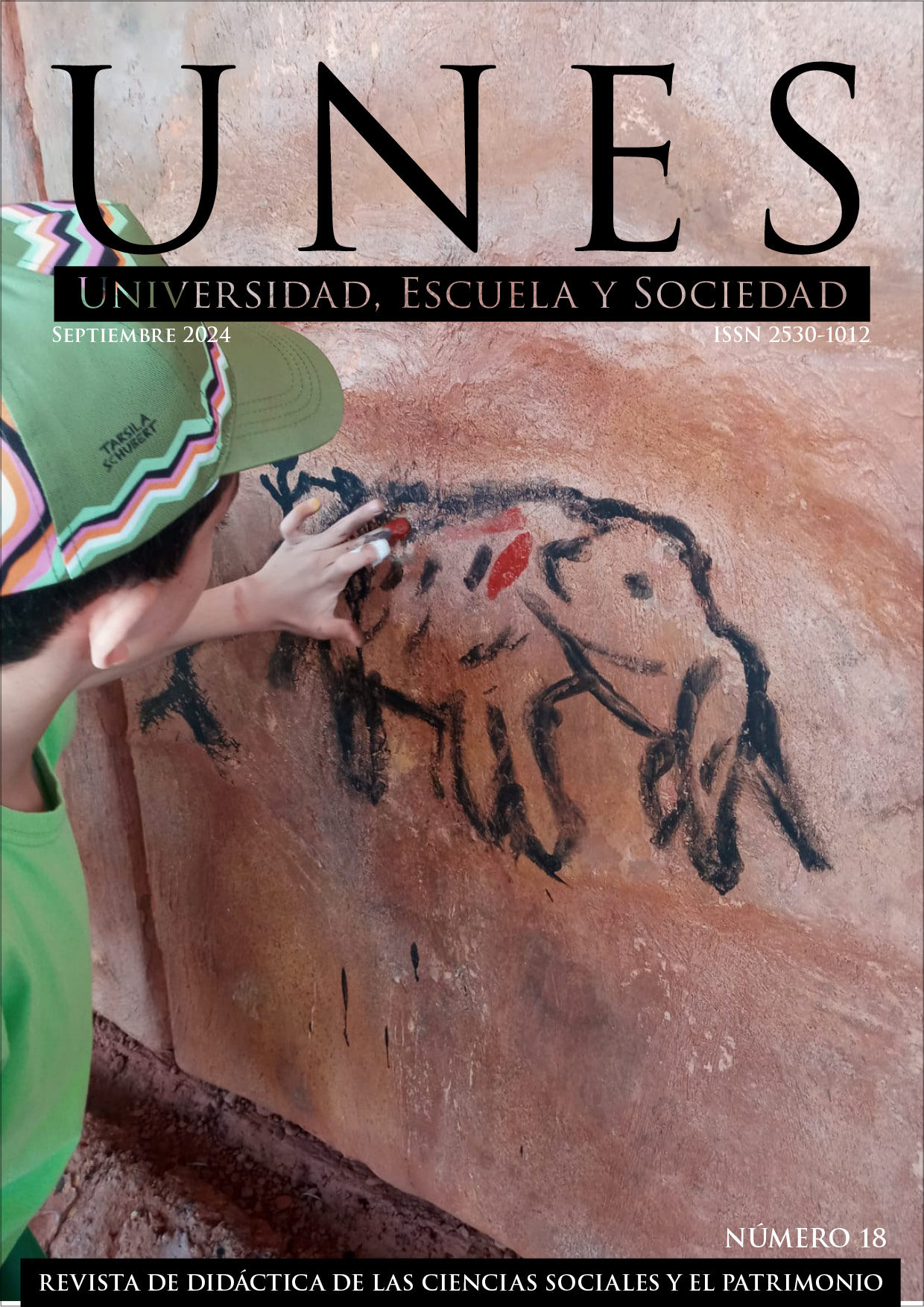The Noguera Learning Field, educate from Archeology and Prehistory in formal education
DOI:
https://doi.org/10.30827/unes.i18.31222Keywords:
Didactics of history; learning by discovery; education for citizenshipAbstract
Introduction: The Noguera Learning Camp is an educational service of the Department of Education of the Generalitat of Catalonia. It began its educational activities in the 2006-2007 academic year. Since then, it has been developing educational activities, aimed at students between 3 and 18 years old and organized at different levels of approach, in relation to Archeology and Prehistory under the heading “Touching history”.
Method: The main purpose of the development of the didactic activities is to provoke in the students the feeling of immersion in the prehistoric past and in the archaeological method as a tool to understand this past. Depending on the type of activities, the teaching methodologies developed and/or the resources used may be different.
Results: Nineteen years after its creation, the Noguera Learning Field has become a benchmark in the field of formal education linked to the teaching of Archaeology, Prehistory, and Heritage. Its educational proposal, focused on what we have defined as didactic experimentation in archaeology, allows students to approach the past by developing different aspects, in connection with relevant aspects of the current world.
Conclusions: The experience developed by the Noguera Learning Field shows the educational value of History (in this case Prehistory), as a tool for the development of critical thinking and social behaviors based on cooperation and citizen commitment.
Downloads
References
Bardavio, A. y González, P. (2003). Objetos en el tiempo. Las fuentes materiales en la enseñanza de las ciencias sociales. ICE UB / Horsori Ed.
Bardavio, A., Mañé, S. y Cháfer, S. (2024). Aprofitament didàctic d’un jaciment de neandertals. La Roca dels Bous i el Camp d’Aprenentatge de la Noguera. Nokaria,3, 47-56. Museu de la Noguera. https://museucn.com/uploads/files/pdf_s/NOKARIA_III.pdf.
Bardavio, A., Mañé, S. y Tort, X. (2023). Las mujeres en la prehistoria. Rompiendo estereotipos desde la educación. Iber. Didáctica de las Ciencias Sociales, Geografía e Historia, 113, 59-64. Graó Ed.
Bardavio, A. y Mañé, S. (2018). El campo de aprendizaje de la Noguera. Formar desde la arqueología y el patrimonio de la prehistoria en la educación pública. Egea, A., Arias, L. & Santacana, J. (Eds.). Y la arqueología llegó al aula. La cultura material y el método arqueológico para la enseñanza de la historia y el patrimonio. 291-328. Ediciones Trea.
Belmonte, M. (2002). Enseñar a investigar. Orientaciones prácticas. Ediciones Mensajero.
Borrell, M., Bosch, J., Buch, M. & Palomo, A. (2013). Parque arqueológico Minas de Gavà (Baix Llobregat- Barcelona). Experimentación, experiencia y recursos educativos. En Palomo A., Piqué R. & Terrades X. (Eds.), Experimentación en arqueología. Estudio y difusión del pasado. 25 (1), 29-3
Buch, M., Comellas, S & Palomo A. (2013). Arqueología experimental: un recurso para el aprendizaje significativo y de descubrimiento en el poblado neolítico de la Draga (Banyoles). Palomo A., Piqué R. y Terrades X. (Eds.), Experimentación en arqueología. Estudio y difusión del pasado. 25 (1), 35-42.
English Heritage (2024). Our vision and values. ENGLISH HERITAGE. ABOUT US. https://www.english-heritage.org.uk/about-us/our-values/#
Ferrández, M., Lafuente, A., López, Joan y Plens, M. (1991). La necròpolis tumular d’incineració de la Colomina 1 (Gerb, La Noguera). Campanya d’excavacions 1987-1988. Revista d’Arqueologia de Ponent,1,83-139. https://raco.cat/index.php/RAP/article/view/250895.
Jardón, P. (2021). Una educación inclusiva de genero con perspectiva crítica. ¿Como incorporar la historia de las mujeres si yo no las estudié?. Iber, didàctica de las ciències sociales, geografía e historia, 103, 29-33.
Sánchez, M. (2022). Prehistorias de mujeres. Ediciones Destino.
Leroi-Gourhan, A. y Brezillon, M. (1972). Fouilles de Pincevent, essai d’analyse ethnographique d’un habitat Magdalenien. Gallia Préhistoire, CNRS.
Martínez-Moreno, J., Mora, R., Torre, I. y Casanova, J. (2006). La Roca dels Bous en el contexto del Paleolítico Medio final del Noreste de la Península Ibérica. Zona Arqueológica, 7, 252-263.
Mora, R., Díaz, J., Bordas, A. y Rosell,M. (1995). El Vallès fa 6000 anys. Fundació Cultural Caixa de Terrassa / UAB.
Santacana, J. (11 de novembre de 2017). Arqueología experimental & Arqueología experiencial. Didàctica del patrimoni cultural. https://didcticadelpatrimonicultural.blogspot.com/2017/11/arqueologia-experimental-arqueologia.html
Santacana, J y Serrat (2002), L’ensenyament de la història i el líving history. Temps d’Educació, 26, 53-65. https://www.raco.cat/index.php/TempsEducacio/article/download/126335/175915
Downloads
Published
How to Cite
Issue
Section
License
Copyright (c) 2024 Antoni Bardavio Novi, Sònia Mañé Orozco

This work is licensed under a Creative Commons Attribution-NonCommercial-ShareAlike 4.0 International License.
Authors being published in this journal agree to the following terms:
The authors retain their copyrights but guarantee the journal's right to be the first publisher of the work, licensed under a Creative Commons Attribution-NonCommercial-ShareAlike 4.0 International license, which allows others to share the work, provided that they acknowledge its authorship and initial publication in this journal.
Authors may separately subscribe additional agreements for the non-exclusive distribution of the work published in the journal (for example, including it in an institutional repository or publishing it in a book), with recognition of its initial publication in this journal.
Authors are allowed and encouraged to disseminate their work electronically (for example, in institutional repositories or on their own websites) before and during the submission process, as this may result in productive exchanges, as well as more and earlier citations of the works to be published (See The Effect of Open Access) (in English).






 ISSN-e: 2530-1012
ISSN-e: 2530-1012









